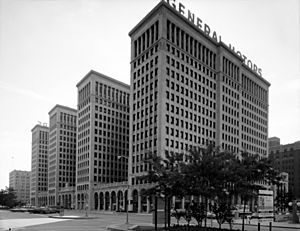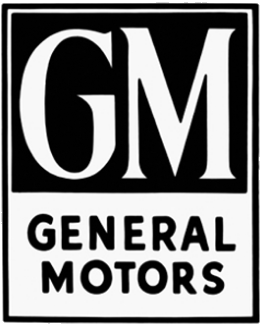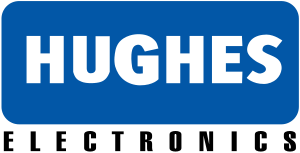History of General Motors facts for kids

General Motors (GM) is one of the world's largest companies that makes cars and trucks. Its history goes back over 100 years! GM was started in 1908 in Flint, Michigan, as a company that owned other companies. By 2012, it had about 209,000 employees all over the world. GM's main office is in Detroit, Michigan, USA. The company builds cars and trucks in 35 countries. In 2008, GM sold 8.35 million cars and trucks. Some of its well-known car brands today are Buick, Cadillac, Chevrolet, GMC, and Wuling.
GM has also owned other types of businesses. These include companies that made construction vehicles, train engines, transmissions, refrigerators, and even airplanes! Many of these were sold off between the 1980s and 2000s.
Contents
How General Motors Started (1908–1929)

General Motors was founded by William C. Durant on September 16, 1908. It started as a "holding company," which means it bought and owned many other companies. The very next day, GM bought the Buick Motor Company. Soon after, it quickly bought more than twenty other companies. These included famous names like Oldsmobile, Cadillac, and Oakland Motor Car Company.
Durant had a successful carriage company before starting GM. This company, called Durant-Dort Carriage Company, made over 100,000 carriages a year by 1900. Some people think GM's story really began with this earlier company.
GM kept growing under Durant's leadership. In 1908, it acquired Oldsmobile. The next year, it added Cadillac, Cartercar, and Oakland. GM also bought the companies that would later become GMC Truck. A Rapid truck (from one of these companies) was the first truck to climb Pikes Peak in 1909!
At first, GM brought together different car makers who were competing with the Ford Motor Company. Ford's Model T, introduced in 1908, was very popular and came only in black. GM decided to offer something different. While the Model T was simple and cheap, GM offered cars in many colors and with different engine sizes and features. This gave buyers more choices.
Durant lost control of GM in 1910 because the company had too much debt. He then started a new company called Chevrolet Motor Company in 1911 with Louis Chevrolet. Durant later got back control of GM in 1916 because Chevrolet became very successful and owned a large part of GM. Chevrolet officially joined GM in 1918.
In 1918, GM also bought the Chevrolet stock from McLaughlin Motor Car Company in Canada. This company became General Motors of Canada Ltd..
GM grew a lot in 1918, with employees increasing from 49,000 to 85,000 workers. Many new workers came from the southern United States and Europe to work in GM's Michigan factories. To help them, GM built employee housing. The company also started a program where employees could invest part of their pay, and GM would match their investment.
GM's main office was in Flint until the mid-1920s, when it moved to Detroit. The new headquarters building was finished in 1923. It was later named the General Motors Building in 1929. GM stayed in this building, now called Cadillac Place, until 1996.
In 1925, GM bought Vauxhall in England. In 1929, it bought 80% of the German car maker Opel, and then 100% two years later. In 1931, GM also bought Holden in Australia.
In 1926, GM created the Pontiac brand. It was meant to be a "companion" to the Oakland brand. Pontiac became so popular that the Oakland brand was stopped, and the division was renamed Pontiac.
GM also bought the Hertz car rental system and the Yellow Cab and Yellow Coach bus companies in 1926. It even helped create Greyhound bus lines.
During this time, GM's president, Alfred P. Sloan, came up with a smart plan. He made sure each GM car brand appealed to a different type of buyer. For example, Chevrolet was for entry-level buyers, while Cadillac was for those who wanted luxury. This created a "ladder of success" for customers. GM also offered car loans through GMAC (started in 1919), making it easier for more people to buy cars.
GM's Growth and Challenges (1929–1980)
The 1930s and World War II
In the 1930s, GM also got into making aircraft. It bought several airplane companies and merged them into North American Aviation. However, GM later sold off its interest in aircraft manufacturing in 1948.
GM also bought companies that made train engines in 1930. These became the General Motors Electro-Motive Division. During World War II, these engines were important for American submarines and ships.
In 1935, the United Auto Workers (UAW) labor union was formed. In 1936, the UAW organized the Flint Sit-Down Strike at GM plants. This strike led to violence in Flint when police tried to arrest workers. The strike ended in 1937 when GM agreed to recognize the UAW as the union for its workers.
During World War II, General Motors made huge amounts of weapons, vehicles, and aircraft for the Allied forces. GM's William S. Knudsen even led U.S. wartime production for President Franklin D. Roosevelt. GM's UK division, Vauxhall Motors, built Churchill tanks for the Allies. GM of Canada also made 500,000 military trucks.
GM's German company, Adam Opel AG, was controlled by the German government during the war. After the war, GM received money for damages to its German factories caused by Allied bombing.
After the War: Big Success and New Problems
After World War II, GM grew to be the largest company in the United States. In 1953, Charles Erwin Wilson, who was GM's president, became the U.S. Secretary of Defense. He famously said, "what was good for the country was good for General Motors and vice versa."
GM was one of the biggest employers in the world. In 1955, it was the first American company to pay over $1 billion in taxes. At this time, GM had five main car brands: Cadillac, Buick, Oldsmobile, Pontiac, and Chevrolet, each at a different price level.
By the late 1950s, the differences between GM's car brands started to become less clear. Cars from different divisions began to look similar and cost similar amounts.
The 1960s saw GM create smaller cars. The Chevrolet Corvair was GM's answer to the Volkswagen Beetle. Later, the Chevrolet Camaro was made to compete with the Ford Mustang.
In 1974, GM was the first big car company to offer airbags as an option in some of its cars. However, not many people chose this option, so it was stopped after 1976. Airbags became standard in cars much later.
GM faced some challenges with its new car models during this period.
- The Chevrolet Corvair, introduced in 1959, was popular at first. But it got a bad reputation for being unsafe, especially after consumer advocate Ralph Nader wrote a book about it in 1965. Even though GM improved the car, sales went down, and it was stopped in 1969.
- The Chevrolet Vega, launched in 1971, also started popular. But it had many quality problems, which gave it a bad name. It was stopped in 1977.
- In 1977, Oldsmobile cars were so popular that GM couldn't make enough of their special V8 engines. So, Oldsmobile started putting Chevrolet engines in some of its cars without telling customers. This led to a big lawsuit and a public relations problem for GM. After this, GM stopped linking specific engines to specific car divisions.
Modern General Motors (1980–Present)
Changes and Challenges
In the 1980s, Roger B. Smith was GM's CEO. GM faced financial difficulties in the early 1980s but later recovered. Smith tried to make GM more efficient by using more automated factories. He also created the Saturn brand to make smaller cars. GM also partnered with Japanese companies like Toyota and Suzuki to build cars.
The 1990s started with an economic downturn, which hurt GM's profits. John F. Smith Jr. (Jack Smith) took over and made big changes to cut costs and improve cars. These changes helped GM recover.
GM's profits improved in the late 1990s, especially from selling many trucks and SUVs. However, GM faced issues with its former executive, José Ignacio López, who left to work for Volkswagen. GM accused him of taking secret documents, which led to a lawsuit. Volkswagen later paid GM $100 million to settle the case.
In 1998, a strike at a GM parts factory in Flint, Michigan, spread to other plants and lasted seven weeks. This strike had a noticeable effect on the national economy.
In the early 2000s, GM faced a big problem with its pension and benefit funds for retired employees. This was made worse by a drop in the stock market after the September 11, 2001 attacks. GM had to make big changes to save money.
Focus on Trucks and SUVs
In the late 1990s, the U.S. economy was strong, and GM made a lot of money selling light trucks and SUVs. In 2004, GM decided to put more effort into updating its trucks and SUVs. This happened just before fuel prices went up a lot, which made these bigger vehicles less popular. GM then started to advertise its trucks and SUVs as having the best fuel economy in their class.
Financial Restructuring
GM worked hard to fix its financial problems. It sold off parts of its business, like its financing unit (GMAC, now Ally Financial) and its Allison Transmission division. These sales helped GM get more cash.
In 2007, the United Auto Workers union went on strike against GM. It was the first nationwide strike since 1970. However, a deal was reached quickly, and the strike ended within two days.
Great Recession and Reorganization
In late 2008, during a big economic crisis, GM received loans from the American and Canadian governments to help it survive.
On April 27, 2009, GM announced that it would stop making Pontiac cars by the end of 2010. It decided to focus on four main brands in North America: Chevrolet, Cadillac, Buick, and GMC. GM also tried to sell its Hummer, Saab, and Saturn brands, but those deals didn't work out. The company had already closed its Oldsmobile division in 2004.
In 2009, GM changed its official name from General Motors Corporation to General Motors Company.
In 2012, GM formed a partnership with PSA Peugeot Citroën of France. GM bought a small part of PSA, but later sold it in 2013. In 2017, GM sold its Opel and Vauxhall brands to the PSA Group for $2.3 billion. GM had lost money in its European operations for many years.
GM Around the World
General Motors in South Africa
GM faced criticism for having a presence in South Africa during apartheid (a system of racial segregation). The company eventually left after pressure from customers and others. However, its Opel brand continued to have a commercial presence there.
General Motors in Argentina
General Motors started in Argentina in 1925, making cars like the Double Phaeton. Sales grew quickly, and more brands like Oldsmobile and Pontiac were added. A new, larger factory opened in 1929.
During World War II, it became hard to get parts, and car production stopped in 1942. To keep the company going, GM made things like refrigerators and car accessories. After the war, car production restarted, including Chevrolet pickups and popular Chevrolet models like the Chevrolet 400 and Chevrolet Chevy.
Companies That Started at GM
Over the years, several important companies that were once part of GM became independent.
Electronic Data Systems (EDS)
In 1984, GM bought Electronic Data Systems Corporation (EDS), a big company that provided computer and technology services. EDS became independent again in 1996 but continued to provide IT services to GM for many years.
Delco Electronics
Delco Electronics Corporation was GM's company for designing and making car electronics. The name Delco came from the Dayton Engineering Laboratories Co. Delco was responsible for many new ideas, like the first reliable battery ignition system and the first practical car self-starter.
In 1936, Delco started making the first car radios that were installed in the dashboard. By the 1970s, Delco was a major supplier of car electronics.
In 1985, GM bought Hughes Aircraft and combined it with Delco Electronics to form Hughes Electronics Corporation. Later, the defense parts of Hughes Electronics were sold to Raytheon, and the commercial parts of Delco Electronics went to GM's Delphi Automotive Systems business.
Hughes Electronics Corporation
Hughes Electronics Corporation was formed in 1985 when GM bought Hughes Aircraft Company. This company was a major maker of aerospace and defense products, as well as communication systems. The defense business was sold to Raytheon in 1997, and the space and communications part was sold to Boeing in 2000. The remaining parts of Hughes Electronics were sold in 2003 and renamed The DirecTV Group.
Delphi Corporation
Delphi was a large company that made car parts. It was spun off from General Motors in 1999. Delphi had many factories and employees around the world. In 2005, Delphi filed for bankruptcy and later sold or closed many of its plants.
Diesel Engines
GM also had companies that made diesel engines. Detroit Diesel made diesel engines for trucks, generators, and marine use. Electro-Motive Diesel (EMD) made diesel engines and locomotives (train engines).
General Motors Acceptance Corporation (GMAC)
GMAC was GM's financing company, which helped people buy GM cars. By the end of 2006, GM had sold most of its ownership in GMAC.
GM Leadership
Here are some of the important leaders who have served General Motors over the years.
Chairmen of the Board of General Motors
- Thomas Neal (1912–1915)
- Pierre S. du Pont (1915–1929)
- Lammot du Pont II (1929–1937)
- Alfred P. Sloan Jr. (1937–1956)
- Albert Bradley (1956–1958)
- Frederic G. Donner (1958–1967)
- James M. Roche (1967–1971)
- Richard C. Gerstenberg (1972–1974)
- Thomas A. Murphy (1974–1980)
- Roger B. Smith (1981–1990)
- Robert C. Stempel (1990–1992)
- John G. Smale (1992–1995)
- John F. "Jack" Smith Jr. (1996–2003)
- G. Richard Wagoner Jr. (2003–2009)
- Kent Kresa (2009)
- Edward ("Ed") Whitacre Jr. (2009–2010)
- Dan Akerson (2010–2014)
- Tim Solso (2014–2016)
- Mary Barra (2016–Present)
Chief Executive Officers of General Motors
- Alfred P. Sloan Jr. (1923–1946)
- Charles Erwin Wilson (1946–1953)
- Harlow H. Curtice (1953–1958)
- James M. Roche (1967–1971)
- Richard C. Gerstenberg (1972–1974)
- Thomas A. Murphy (1974–1980)
- Roger B. Smith (1981–1990)
- Robert C. Stempel (1990–1992)
- John F. "Jack" Smith Jr. (1992–2000)
- G. Richard Wagoner Jr. (2000–2009)
- Frederick A. "Fritz" Henderson (2009)
- Edward ("Ed") Whitacre Jr. (2009–2010)
- Dan Akerson (2010–2014)
- Mary Barra (2014–Present)
Presidents of General Motors
- George E. Daniels (1908)
- William M. Eaton (1908–1910)
- James J. Storrow (1910–1911)
- Thomas Neal (1911–1912)
- Charles W. Nash (1912–1916)
- William C. Durant (1916–1920)
- Pierre S. du Pont (1920–1923)
- Alfred P. Sloan Jr. (1923–1937)
- William S. Knudsen (1937–1940)
- Charles E. Wilson (1941–1953)
- Harlow H. Curtice (1953–1958)
- John F. Gordon (1958–1965)
- James M. Roche (1965–1967)
- Edward N. Cole (1967–1974)
- Elliott M. Estes (1974–1981)
- F. James McDonald (1981–1987)
- Robert C. Stempel (1987–1990)
- Lloyd E. Reuss (1990–1992)
- John F. "Jack" Smith Jr. (1992–1998)
- G. Richard Wagoner Jr. (1998–2009)
- Frederick A. "Fritz" Henderson (2009)
- Dan Ammann (2014–2019)
- Mark Reuss (2019)
Important Issues and Events
Safety Concerns and Ralph Nader
Consumer advocate Ralph Nader criticized GM for safety issues in its cars, especially the Chevrolet Corvair, in his 1965 book Unsafe at Any Speed. Nader became famous for fighting for car safety. GM was accused of trying to intimidate Nader. At a Senate hearing in 1966, GM's CEO apologized to Nader. These hearings led to new laws that created the United States Department of Transportation and other safety agencies.
EV1 Electric Car
The General Motors EV1 was an electric car produced by GM in the 1990s. It was one of the first modern electric cars made by a major automaker.




